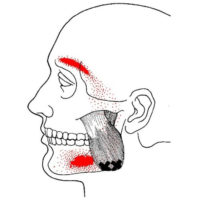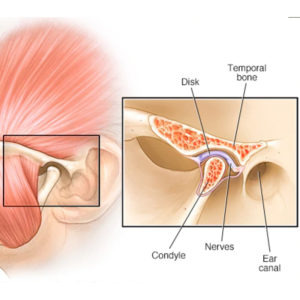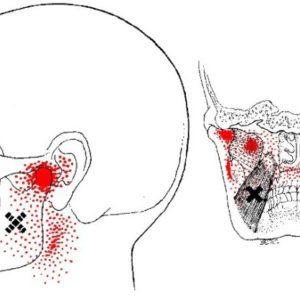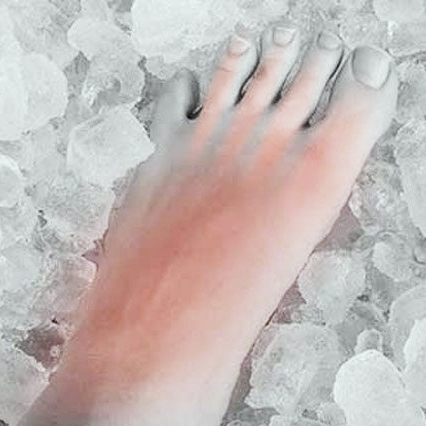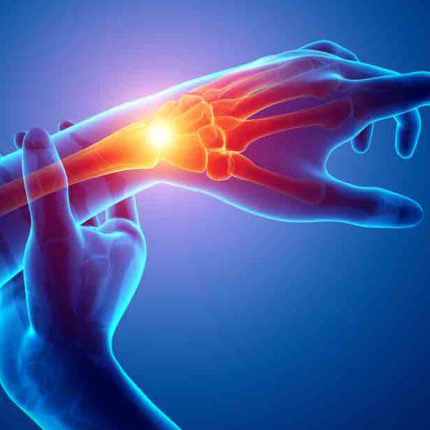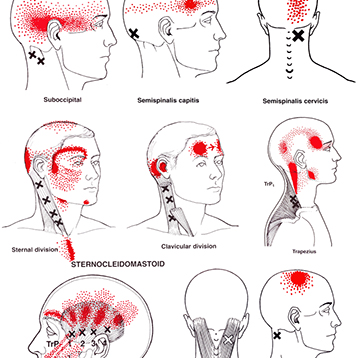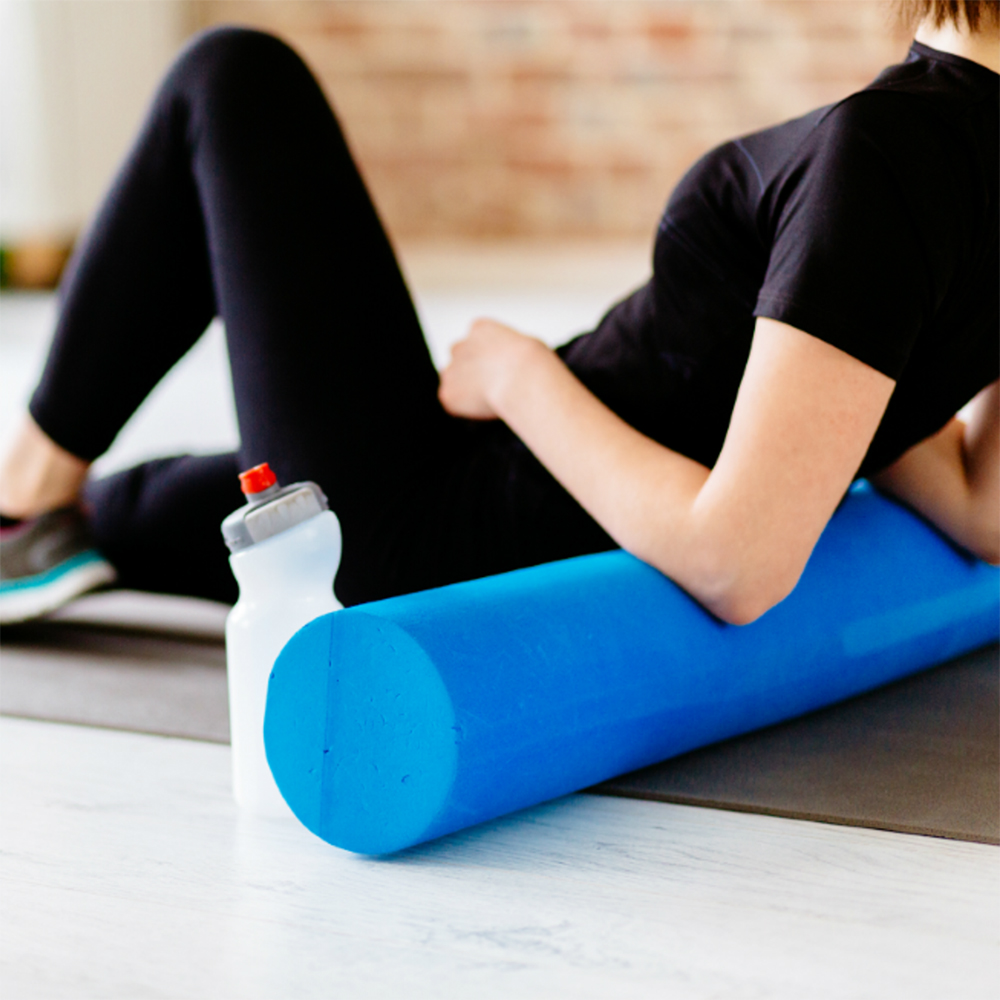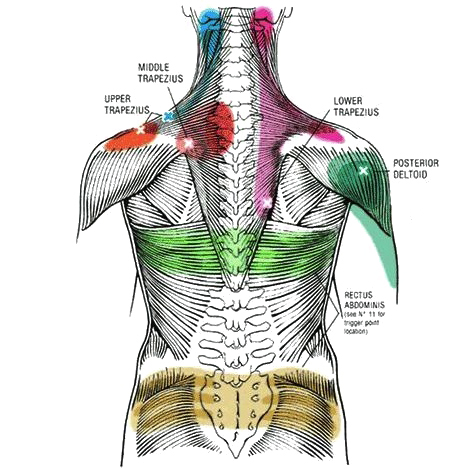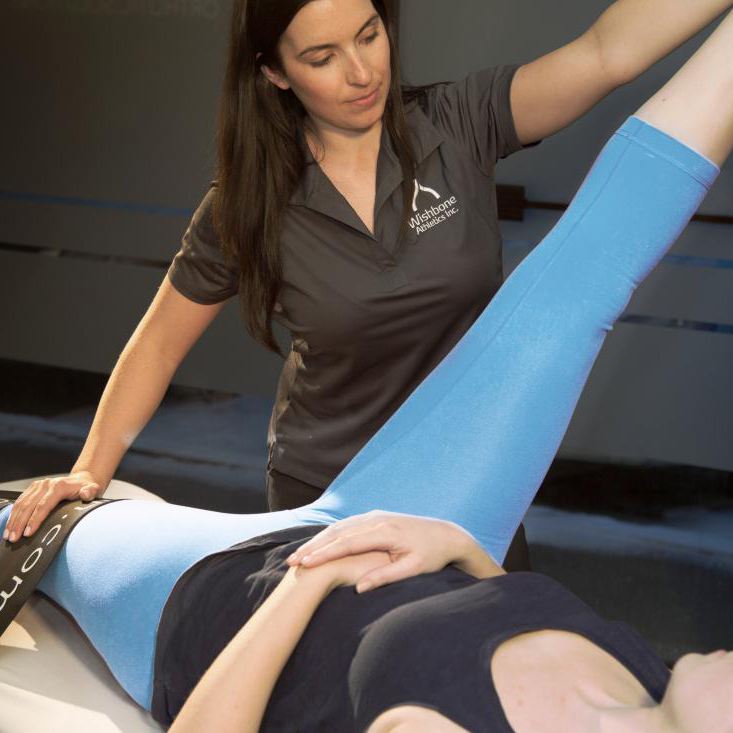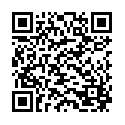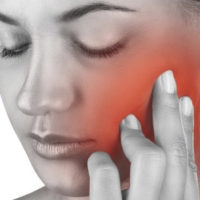
If you have a TMJ Headache – Myofascial Pain should be on your radar! Problems with the Temporo-Mandibular Joint (TMJ) cause pain in the face and head. In addition, TMJ disorders (TMJD) can cause myofascial problems AND myofascial dysfunction can cause TMJ pain, reinforcing each other.
Sometimes, TMJ headache – myofascial pain also feeds tension and migraine headaches. For general headache info, please see this intro.
TMJ pain and headache is the primary symptom of TMJ Disorder or TMJD. This is an umbrella term that includes a variety of symptoms and causes.
For most people, pain in the face and side of the head is the primary symptom. Sometimes, TMJ issues cause headaches in the back of the head.
Conventionally, TMJ disorders have been considered as a type of musculoskeletal, neuromuscular, or rheumatological disorder. It has also been called a functional pain syndrome, and a psychogenic disorder.
However, in our experience, a significant number of TMJD patients also have myofascial pain in key muscles that act on that jaw. Sometimes, this happens in response to a problem in the jaw joint. Other times, TMJ headache – myofascial pain IS the problem.
Like other forms of headache, TMJ headache can get worse through ‘central sensitivity syndrome’.
For treatment of TMJ headache – myofascial pain relief is a practical treatment.
In a word, “Yes!”
Cluster headaches have some symptoms that are similar to migraines. They can be trigger like migraines. They may some variation of aura, which suggests a vascular component.
However, cluster headache is a neurological disorder. Distinguishing symptoms are the rapid cycling of the headaches, extreme pain, autonomic symptoms and prevalence in men.
Extensive studies of the brain, in particular specific areas of the hypothalamus, have shown unusual activity.
Current therapy focuses on medications that target these areas.
Myofascial trigger points and dysfunction often develop in muscles of the face, head and neck in response to the rapid cycling, extreme pain.
TMJ Pain Characteristics
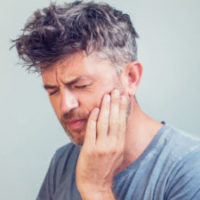
You have pain and tenderness the muscles around your jaw. Sometimes it feels like the joint itself the joint itself, just in front of your ear. Pain is the defining feature of TMD.
Usually, it is aggravated by manipulation or substantial use, such as when chewing, clenching, or yawning. Also it is often worse upon waking.This may be due to clenching during the sleep.
Your pain usually has adull or aching quality. Typcially, it is poorly localized and intermittent. However, sometime it can be constant. The pain is more usually unilateral (located on one side) rather than bilateral.
Common Symptoms
- Limited range of jaw movement, which may cause difficulty eating or even talking. Your jaw might even lock. In addition, you have stiffness in yourjaw muscles and the joints, especially upon waking. Also, you may have incoordination, asymmetry or deviation of mandibular movement.
- Noises from the jaw joint during movement, often intermittent. Joint noises may be described as clicking, popping, or grating.
- Headache in the back of your head or forehead; or other types of facial pain including myofascial pain.
Less Common Symptoms
- Pain your teeth or neck.
- Hearing loss.
- Tinnitus.
- Dizziness.
- Sensation that your teeth do not meet together properly.
Internal Joint Pain
The temporo-mandibular joint (TMJ) can become mis-aligned and inflamed for various reasons. This is called either TMJ or TM disorder (TMJD or TMD). This diagnosis is most often made by your dentist. Infections, missing teeth and arthritis in the TM joint are typical causes of this.
In this case, the TM joint can cause pain radiating into the face and head. This can be part of a stimulus for central sensitization. Then, the feed-forward mechanism turns periodic TM joint pain into a chronic headache. The best way to approach this is to address the underlying dental problem.
Myofascial Reaction to Jaw Issues
On the other hand, relatively minor problems with your TM joint can cause muscles in your face and head to splint. In response, these muscles can develop taut bands and trigger points. Underlying causes of this type of TM joint issue are clenching, bruxism at night and teeth that don’t meet properly because of missed orthodontic work. Night guards are helpful. Trigger points can be released to provide relief from most of the pain.
Primary Myofascial TMJ Pain
Lastly, it is possible that you have a myofascial problem with muscles of the face and head that has caused inflammation of your TM joint.
Myofascial treatment for TMD includes, work with the temporalis, masseter, pterygoids, digastric, hyoids, SCM, scalenes, trapezius, longus colli and suboccipitals.
You have some muscles that are easily accessible from the outside of the head that are probably part of the story. However, there are also important muscles inside the mouth. We can provide advice and training for you to access those muscles in self-care.
TMJ Headache – Myofascial Pain
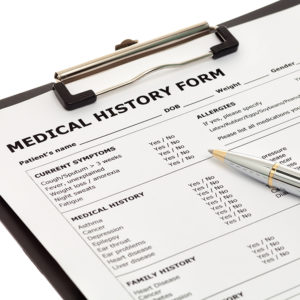
Chronic Headache - Myofascial TriggerPoint Referral Patterns
We can clearly see how referral patterns of head and neck muscles evoke the pain patterns of migraines, tension headaches, cervicogenic headaches. They even overlay the symptoms of cluster headaches and TMJ headache pain. Some of the factors that activate those muscles may not covered by doctors. Those activation factors are things we care a lot about.Myofascial activations are a part of most headache patterns!
Repetitive Use
When ever we are making repetitive movements, we should be mind of using proper body mechanics. This will help minimize repetitive stress injuries and myofascial activations. For instance, lifting in a stooped posture and then twisting is always ill-advised. Doing it repetitively is worse. Therefore, if this type of lifting is required, we should rethink the task and try to organize it in a way that reduces stooping and twisting. However, even simple movements matter. For instance, what if your desk is arranged phone on the wrong side. In fact, with every call, you have to twist your head and neck and reach over with your arm to the wrong side of the desk This is poor body mechanics. Fixing it might be as simple as moving the phone. It pays to think about basic body mechanics in this common sense way each time we engage in a repetitive activity. Fortunately, we're starting to teach this important skill to young people, as in this student guide at University of Michigan.Overload
We can experience chronic overload when we do things like wear high heels, carry a heavy bag or lean into our work. However, acute overload happens when we decide to lift, push, pull or otherwise move something that is too heavy for us. Most often, we overload our muacles with an eccentric contraction. For example, lifting a heavy box, correctly using your legs instead of your back, requires concentric contractions of your quads. However, setting that same heavy box down, slowly and with control, require eccentric, lengthening contractions. These should be done carefully.Spill it!
Of course, if you have a diagnosis from your doctor, we need to know. If you have recent imaging or other test results, even better! We've all been knocked around a bit. We'd like to know everything you can think of about prior accidents, injuries, surgeries and other treatments. It is important to know about previous or current medical conditions that could impact our treatment. Anything from high blood pressure to TMJD to disc problems are vital information. Hopefully, medications align with your diagnosis. Sometimes, certain medications will also modify our reatment options. Some drugs interfere with nutrient absorbtion. Increasingly, supplement use is common and we'll review that with you as well.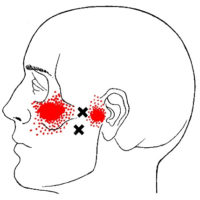
TMJ Headache – Myofascial Pain Referrals Overlap Joint Pain
Your dentist should evaluate you for dental issues that may be contributing to TMJ disorder. Generally we assume that some of the muscles around the TMJ have also developed myofascial pain.
If dental causes have been eliminated, or are being treated by your dentist, then myofascial trigger point referrals are probably the primary source of the pain in TMJD.
A wide variety of muscles in your face, head and neck can harbor myofascial trigger points. The lateral pterygoid, pictured here is one of several likely myofascial suspects.
The pain of TMJ headache itself usually focuses near your jaw. But you may also have a headache in back of your head or your forehead. Even jaw pain has individual trigger points for specific muscles such as the masseter pictured here, versus the lateral pterygoid previously and the medial pterygoid below.
Where Does The Pain Refer?
When looking for trigger point referrals, we are considering the whole range of head and neck muscles. The precise pain patterns are quite varied. They can also extend into your cheeks, temples, jaw and more.
TMJ headache – myofascial pain can be relieved easily with trigger point therapy.
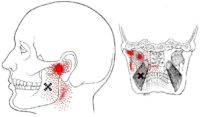 It pays to be precise. Notice that this pattern in the medial pterygoids is different in subtle but important ways from the lateral pterygoids, pictured at the start of the section.
It pays to be precise. Notice that this pattern in the medial pterygoids is different in subtle but important ways from the lateral pterygoids, pictured at the start of the section.
Determining which muscles are referring pain is crucial to myofascial trigger point treatment…
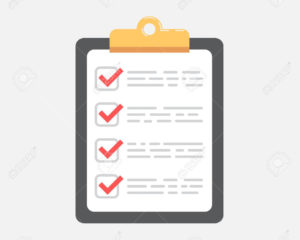
Trigger Point Therapy can get at some aspects of myofascial pain that you might not have thought of!
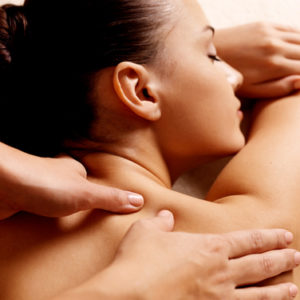
Myofascial tigger point therapy - it's how you work this!
Manual Therapy Techniques
First, we specifically expertly use manual pressure release therapy, neuromuscular techniques, and deep stroking, friction, skin rolling. When indicated, we also use fascial stretching. Sometimes, we use less common techniques like cupping, spray and stretch and acoustic compression.Muscle Activation
In addition, we may also use active and passive muscle activation techniques. This includes reciprocal inhibition, postisometric relaxation, contract/relax, strain/counter-strain and muscle energy techniques. Sometimes, we also use hot/cold therapy.Range of Motion/Testing
Finally, routinely run the muscle we are treating through its entire, pain-free range of motion. This is part of your treatment. However, it also the start of a new test/assess cycle. We learn together whether your range of motion has increased and whether your pain is reduced. We may have you get up and use your body in the way that causes pain to 'test' more dynamically. As we finish our hand-on work, we transition into learning new movement strategies and self-care.Myofascial tigger point therapy - it's how you work this!
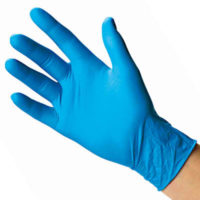
TMJ Headache – Myofascial Pain Trigger Point Compression
For treating the muscles of chewing, we may use a tennis ball or small rubber ball to gently compress them externally. A small ball rolled between the face and your hand is a useful technique. This includes the masseter (side of the cheek), the temporalis (the temples) and digastric muscle under the jaw.
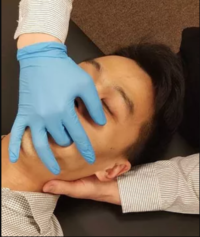 In this photo, the therapist is treating muscles of chewing from the inside. This could include the lateral and medial pterygoids and inner masseter. In addition, there are some smaller muscles near the roof of the mouth and base of the tongue than can be released.
In this photo, the therapist is treating muscles of chewing from the inside. This could include the lateral and medial pterygoids and inner masseter. In addition, there are some smaller muscles near the roof of the mouth and base of the tongue than can be released.
Your therapist can train you to perform this type of self-care at home. At first, it might seem weird. But soon, you will amazed at how much it helps!
Myofascial self-care helps reduce the frequency and severity of migraines!
TMJ Headache – Myofascial Pain Trigger Point Therapy Self-Care Stretches
We don’t typically ‘stretch’ the muscles of chewing. As with other muscles during self-care, we do run them through their range of motion. But, we do not stretch, per se.
Typically, certain other muscles tend to be tight in most chronic headache patients. Your therapist will give you specific advice about muscles that you should stretch.
However, most of us need to stretch our pecs, SCM, upper traps and levator scapula. After self-compression, these muscles can be stretched gently and effectively. You may also benefit from stretches of certain muscles on the back of your neck. Unfortunately, most of these muscles are over-stretched by head forward posture anyway. Your therapist can help you target specific muscles in the back of the neck.
In addition, this is the time to strengthen your deep cervical flexors, serratus anterior, lower traps and other postural muscles.
Self-care helps reduce the frequency and severity of TMJ Headache – Myofascial Pain!
TMJ Headache – Myofascial Pain
Structural Variations
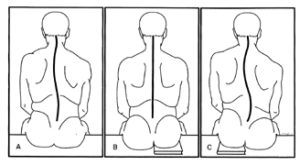
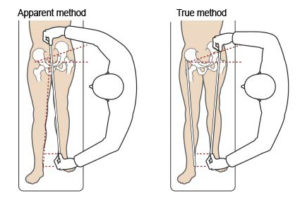
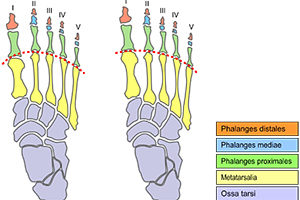
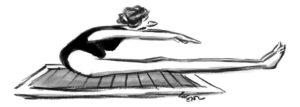
For instance, a difference in either the actual or apparent length our legs is not uncommon. In fact, a difference of 1/4″ can cause myofascial pain.
On the other hand, our legs might be the same length and the two sides of our pelvis might be different sizes. Imbalances caused by myofascial trigger points can pull one side of your hip up while the other falls.
In addition, we can find ourselves out of balance from front to back. For example, this can happen as the result of Morton’s Foot Structure. The slight downward angle created in the foot is like adding a heel to your shoe. Surprisingly, it can pitch your entire body forward. In fact, Morton’s Foot Structure can contribute an inch or more to head forward posture.
Some of us have relatively short upper arms. This means that computers, desks and other furniture is not built for us. Because of this, we might benefit from some changes to our workspace and other environments.
Either way, we are built the way we are and it is ok.1
All of these variations can be accomodated or corrected. Myofascial therapists know how!
How Do You Sit?

Sitting Posture
Obviously, how we sit matters. Of course, there are different kinds of sitting. The way we sit at a desk might be different than how we sit in auto seat or a recliner. However, it should be that different. For instance. in any sitting posture, we want to keep our back fairly straight. Typically, this means no slump in the lumbar spine or upper spine and shoulders. In addition, we want to keep our head and neck reasonably well aligned with our spine. Basically, our hands and arms should be within easy reach of our work - whether it is a keyboard, steering wheel or a desk. Do not lead with your face! Next our legs should be reasonably open at the hip. Unfortunately, the tight flexion of a straight back chair. traditional desk chair or bucket seats shortens our hip flexors and hamstrings. In addition, it overloads our quads and glutes. Finally, it promotes head forward posture overloads the neck and upper spine. Finally, our feet should touch the floor - heels and toe. Often, if you are using a high desk chair, there may be a rail that you can rest your feet on. However, avoid using it. Instead, adjust your chair to a height that allows your feet to touch the floor.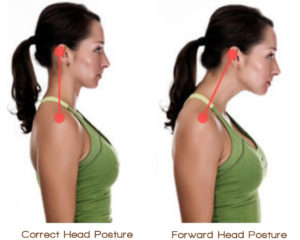
Myofascial and Trigger Point therapists, often recommend simple, gentle exercises to strengthen the deep cervical flexors!
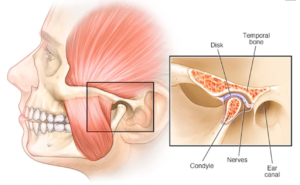
Causes of TMJD Headache
Your temporo-mandibular joint (TMJ) can become mis-aligned and inflamed for various reasons. This is called either TMJ or TM disorder (TMJD or TMD). This diagnosis is most often made by your dentist. Infections, missing teeth and arthritis in the TM joint are typical causes of this.
In this case, the TM joint can cause pain radiating into the face and head. This can be part of a stimulus for central sensitization. Then, the feed-forward mechanism turns periodic TM joint pain into a chronic headache. The best way to approach this is to address the underlying dental problem.
For example, relatively minor problems with your TM joint can cause muscles in your face and head to splint. In response, these muscles can develop taut bands and trigger points.
Underlying causes of this type of TM joint issue are clenching, bruxism at night and teeth that don’t meet properly because of missed orthodontic work. Night guards are helpful. Trigger points can be released to provide relief from most of the pain.
Myofascial Origination of TMJ Pain
Lastly, it is possible that you have a myofascial problem with muscles of the face and head that has caused inflammation of your TM joint.
Myofascial treatment for TMD includes, work with the temporalis, masseter, pterygoids, digastric, hyoids, SCM, scalenes, trapezius, longus colli and suboccipitals.
You have some muscles that are easily accessible from the outside of the head that are probably part of the story. However, there are also important muscles inside the mouth. We can provide advice and training for you to access those muscles in self-care.
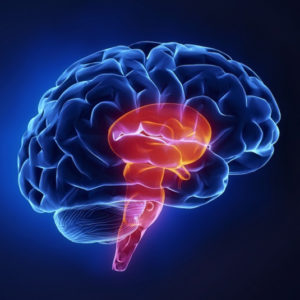
Allodynia
Allodynia occurs when you experience pain from things that are normally not painful. For example, simple touch or pressure become painful. Nerves in the area touched send signals to your brain. But, your nervous system is in a heightened state. So, your brain doesn't produce the mild sensation of touch it should. Instead, it produces pain and discomfort.Hyperalgesia
Hyperalgesia occurs when something painful is more painful than it should be. For example, a simple bump would ordinarily be mildly painful. However, if you are a chronic pain patient it might send your through the roof. Again, your nervous system is more sensitive. Of course, it produces pain that is amplified.Other Symptoms of Central Sensitization
Central sensitivity has other characteristics. They occur less often. For example, it can lead to heightened sensitivities across all your senses. For instance, some chronic pain patients report sensitivities to light, sounds and odors. Normal levels of light can seem too bright. Perfume can produce a headache...3 In addition, central sensitivity may cause cognitive deficits. For instance, this includes poor concentration and poor short-term memory. Also, it corresponds with increased levels of emotional distress, particularly anxiety. After all, the nervous system isn't just responsible for sensations, like pain. In addition, it produces our emotions.4 Central sensitivity can occur with chronic low back pain, chronic neck pain, whiplash injuries, headaches and more.5Fortunately, for Chronic Pain - Myofascial Trigger Point Therapy helps break the cycle...
Get Better Sleep, Reduce Chronic Pain
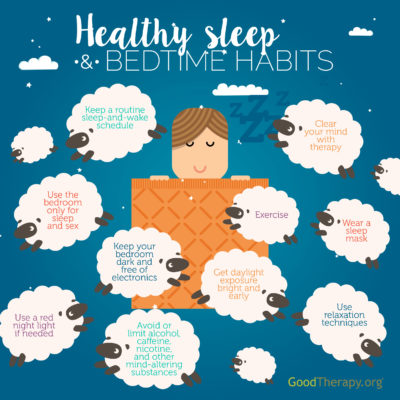
Yes, getting good quality sleep is important!
Sleep is a natural process when we rest and repair ourselves. In fact, a minimum amount of sleep is needed for survival. In addition, we need larger minimum amount of sleep to be at our best.
Ideally, we don’t need to do anything about sleep. We get tired, we go to bed, sleep all night and wake up the next day feel refreshed.
Sadly, sleep often doesn’t go the way we expect. Often, we may be tired when shouldn’t be and unable to fall asleep when we go to bed. Sometimes, we may not sleep through the night. Or, we may sleep enough hours, but not get enough deep sleep. Finally, when we wake up in the morning, for some of us, that is one of the worst times of the day. Now, everything hurts and it takes a significant amount of time to “warm up” and feel better.
First, to get better sleep, we need to do is regulate our schedule.
Set a time to go to bed and get up and stick with it. If you can, the includes weekends.
Also, eating regular meals at consistent times help regulate our systems.
In addition, don’t nap during the day and get adequate sunlight. This helps set your body clock properly.
Avoid habits that interefere with good quality sleep. Make some new good habits. You’ll sleep better!
First, to get better sleep, we need to do is regulate our schedule. Set a time to go to bed and get up and stick with it – even on weekends, if you can. In addition, don’t nap during the day and get adequate sunlight. This helps set your body clock properly.
Avoid habits that interefere with good quality sleep.
Generally, good sleep hygiene is common sense. Most of us already know what do to. But, changing major lifestyle habits is hard. When we realize how far off we’ve gotten from good sleep it can be discouraging.
In that case, consider small steps. Reorganize your bedroom a bit. Focus on reducing just one negative habit and replacing it with one better one.
Rome wasn’t built in a day. One step at a time…
Sleep Posture
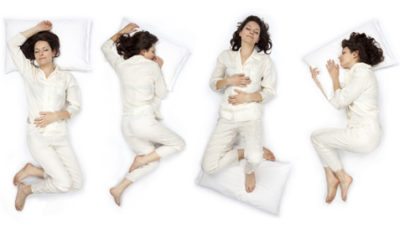
Of course, just as when we are awake, some postures are more likely to cause myofacial problems.
Do you sleep on your back, side or stomach? Maybe half-side, half-stomach? But, if on your side, do you curl up? Generally, sleeping flat on your back with little or no pillow is considered natural and ideal.
In fact, this is how infants naturally sleep. However, as older adults, we may find that sleeping on our backs can aggravate low back pain. Also, we are more likely to experience sleep apnea on our back.
So, for for various reasons some of us sleep on our side or stomach. Unfortunately, when we sleep on our stomach our head and neck are turned to one side. Obviously, this causes problems with muscles in head, neck, shoulders and arms.
Sleeping on your stomach is bad. Period.
Often, side sleeping is a great compromise for many people. However, side sleepers need to pay more attention to pillows than people sleeping in other positions. Also, notice the difference for you between ‘half-stomach/half-side” and being purely on your side. True side sleeping means you are laying on your arm OR that you tend to let your shoulder round in. Pillows can help with this.
Most of us sleep with too many pillows, not enough pillows or the wrong kind of pillows. And, this is potent factor is in perpetuating myofascial pain.
Back Sleepers
We recommend a single, very thin pillow under your head. In addition, if you experience low back pain when laying on your back, you may find that bolster under your knees helps. Of course, this could be another ordinary pillow, but a good bolster is round, thick enough and will hold its shape all night.
Side Sleepers
First, we recommend a thick pillow at the head. If you wake up with a hand or arm tucked under your head, that is your body telling you that your pillow is too thin! Side sleeper pillows are either thick and firm OR they have fill that can be positioned as you want it and will mostly keep its shape during sleep.
Next, let’s think about your arms. Naturally, the arm you are sleeping on needs to be accomodated. Try placing a thin pillow under your rib cage. This creates a “slot” for this arm and shoulder. In addition, your upper arm should rest on a thick, firm pillow or bolster. As much as you love your partner, we all need to find a sleeping position that works for us on our own.
Finally, consider your legs. Unfortunately, flexing the hips and/or knees and curling up close to a fetal position is hard on our hip flexors and hamstrings. Try to avoid this. A thick, firm pillow or bolster should be used in between the lower legs. Remember, the idea is to keep your knees and ankles about the same distance apart as your hips.
Avoid foam…
First, we do not recommend foam pillows of any type. Even if you are happy with your foam mattress, we don’t recommend foam pillows. They do not maintain their thickness. In addition, they ‘jiggle’ which is not good for your neck. Of course, it you have any concerns about the foam material itself, you don’t want it near your nose and mouth all night. Besides, there are a variety of other materials that are better for conventional head pillows.
Next, there are a variety of side sleeper pillows in various shapes, including ‘L’ and ‘J’ shaped. For those who go back and forth between back and side sleeping, consider the “Tri-Core” pillow or similar.
Basically, thick pillows and bolsters used to support your limbs need to keep their shape all night. They should be made with dense cotton stuffing or similar.
Feet and Ankles
Sometimes, we need to pay attention to foot and ankle positioning at night. For instance, if we have myofascial issues in the calf, we want to avoid pointing out toes. So, back sleepers probably want to use a bolster of some type to help keep their ankles from drooping at night.
In addition, this means that we might not want heavy covers or sheets tucked in at the foot of the bed. They will weigh down our toes and point our feet and ankles.
Sleep Hygiene
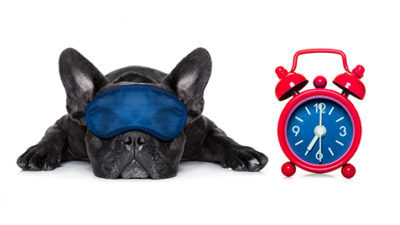
When we are in chronic pain-better sleep is more important than ever. There are many things we commonly eat, drink and imbibe in the evenings that can interfere with your sleep. These are common recommendations for good sleep hygiene.6
Substances
- Caffeine – Some people find that it affects them so strongly that coffee, tea, colas or energy drinks after noon can affect sleep.
- Alcohol – Although alcohol is a depressant, and too much will cause you to pass out, alcohol interferes with your sleep architecture. If you enough, but still feel tired in the morning, consider avoiding alc0hol for 3-4 hours before you go to bed.
- Muscle relaxers, opiates, marijuana (w/THC) – Our advice is similar to alcohol. All are best avoided later in the evening. CBD products may be a different story.
- Liquids – It seems obvious right? We knew this as small children. If you consume significant amounts of liquid before bed, it is much more likely that you will need to get up at night to use the bathroom.
Other Factors
- Blue light – Electronic screens from phones to computers to TVs emit a large amount of blue light that can interfere with sleep. Avoid them for as long as possible before sleep.
- Stress – Getting mentally or emotionally involved in something significant can be stressful. Stress increases cortisol levels. However, cortisol promotes daytime energy and interferes with sleep.
- Exercise – Regular aerobic exercise is good in many ways, including for promoting sleep. However, most of us sleep better if we avoid vigorous exercise in the hours immediately before bed.
If you are already avoiding liquids and getting up at night purely to use the bathroom, this is NOT normal. Men should see a urologist about prostate and/or bladder issues. Both men and women should consider gentle self-care for their pelvic floor. Some pelvic floor issues can be treated externally. Internal therapy for pelvic floor issues is controversial and outside of the scope our practice.
If are able, our bedrooms should be for sleeping only. Our bodies and brains learn what to expect based on what we do and where we do it. If we avoid eating, working, studying and watching TV in the bedroom, it helps to program our system correctly.
We understand biologically that when we go to bed and turn out the lights, it is time for sleep. Instead, if we frequently go to bed, turn out the lights and turn on the TV, we have sent a confusing message to our brain.
Temperature
The temperature of your bedroom under your covers and pajamas is important. If it is already bedtime and we are laying down with the lights out, the next cue that our bodies use is temperature. Cooler temperatures encourage sleep. If you wear pajamas make sure you are not too warm.
Your head, hands and feet are all powerful radiators. If you have trouble falling asleep make sure the room is cool (65-70F), you are not wearing socks, your hands are outside of your covers and your head is uncovered. Maintain adequate humidity in the winter (above 25%).
Avoid drafts, especially on your head and neck. This can activate myofascial trigger points in your neck. Do not make the room too cool. If you are cold at night you are more likely to curl up in a fetal position.
Other Conditions In Your Bedroom
If you have blinds or curtains, use them. Keep your bedroom dark when you are sleeping. Try not to have mirrors positioned that can reflect light on you while you sleep. Avoid flashing lights. Clock radios and other appliances with blue lights can especially troublesome.
Couples
Couples need to work out how to handle schedules that are not aligned. If one of you is having sleeping problems, snoring or otherwise disturbing the other, it may require separate sleeping arrangements for a short while.
Some medications that you are taking may interefere with the amount your sleep. Instead, some can make your sleepy but interfere with the quality of your sleep. Be aware of these effects and discuss them with your doctor.
Medications to promote sleep generally fall into two broad categories.
Medications To Fall Asleep
Melatonin – For example, melatonin is a popular, OTC product that helps us fall asleep. Melatonin is actually a naturally occuring hormone in our body that sends a signal to our brain that it is time for sleep. As we sleep, we use up our melatonin and start making cortisol. When we wake up, our melatonin level should be low and our cortisol level high. This gives us the energy to get through the day. By evening, our cortisol level should be dropping and our melatonin level increasing. The exposure of our eyes to light is one of the ways we make melatonin. If we don’t get enough daylight or our schedule is disrupted by shift work, melatonin 30 minutes before bed might help. We also make less melatonin as we age.
Other sleeping aids, from Sominex to Ambien use different mechanisms to help us fall asleep. Like melatonin, they do not help us STAY asleep.
Medications To Stay Asleep
There are various prescription medications to promote deeper sleep. Consult with your physician for more details.
One of the most commonly prescribed is trazodone. Originally developed as an anti-depressant, small doses of trazodone help some people sleep better. Often, it is prescribed for chronic pain patients. Other types of anti-depressants have also been used to improve sleep.
Pain at night can wake you up. For this reason, muscle relaxants and opiate pain medications may be prescribed before bed. However, these medications may interfere with your sleep architecture. Discuss with your doctor what the best time is for you to take these medications.
Good Sleep Matters!
What Else Contributes To Chronic Headaches?
Do These Things To Feel Better!

- Keep a headache diary - Discover more about what triggers or contributes to your headaches and what treatment is most effective.
- Try relaxation techniques - This can teach you ways to deal with stressful situations. This might help reduce the number of headaches you have.
- Improve your posture - Good posture allows your neck muscles to work properly.
Get Organized
- Improve your work furniture - Consider a standing desk. Make sure your work area is arranged to minimize repetitive head and neck movement.
- Increase aerobic exercise - We go beyond this and encourage healthy movement that my include yoga, dancing, Pilates or other classes.
- Firm up your routines - Don't sleep too much or too little. Set and follow a consistent sleeping schedule. Eat nutritious meals at regular times.
- Drink plenty of fluids - Staying properly hydrated will help, but don't over do it. Alcohol and coffee are dehydrating.
- See The Eye Doctor Regularly - Poorly fitting eyeglasses or improper prescriptions can contribute to headaches. Discuss pros and cons of progressives versus two pairs of glasses, monovision or other approaches.
Coping and support
Living with chronic headaches can be frightening and difficult. The attacks can seem unbearable and make you feel anxious and depressed. Ultimately, they can affect your relationships, your work and the quality of your life. Talking to a counselor or therapist might help you cope with the effects of chronic headaches. And, joining a headache support group can connect you with others. The may have similar experiences and share helpful information.You can do this!
Avoid These Things!
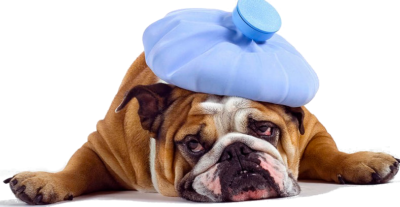
- Stress.
- Smoking.
- Dehydration.
- Excess alcohol.
- Clenching/bruxism.
- Head forward posture.
- Improper (chest) breathing.
- Rebound from caffeine and other medications.
Make Yourself A Priority!
Professional Treatment With Us
Take some time. Treat yourself. You deserve it.
Book a treatment this month and receive 20% off a three session package.
Janet was great. FANTASTIC person who knew how to treat and deal with my conditions. Very informative. Finally, someone who knew what I was talking about.
Really Good
It was interesting, and helpful for my IT band and hip
My experience was wonderful. Janet was very kind and attentive. I felt great after my session and would recommend to try it out.
The lady that assisted me was awesome! I suffer from fibromyalgia and when I left I felt like a brand new person! I plan to return when I get time!
Janet was great - knowledgeable and she found all my "hot spots."
Seriously, if you are looking for massage therapy that actually does your body good--that changes its function for the better and actually makes pain go away--then this is the place you need to come. Not Massage Envy. Not a chiropractor. You need trigger point from knowledgeable experts in the craft.
If your have pain in any part of your body this is the place to go. It focus on the muscles where the pain is. you will feel like a new person. Awesome will be returning. Thanks nice friendly and attentive
amazing!!!
I felt so much better after my appointment. Thank you and thanks for the self care tips!
Experienced therapist. Feel great after appointment...
Highly recommended!
What a great experience. The provider was able to recommend things I can do to improve my pain. Address issues I didn't even share with her that she was able to tell just by her exam and treating me for what i went for. Will be back. Feeling grateful
I spent so much money on chiropractors. This is much better. Everybody should try it out.
Beautiful, relaxing setting. Therapist was knowledgable and professional. I'll be going back. Thank you.
Janet is very informative. I loved that she explained which muscles/groups she was working on. I learned a lot about my posture and why some of my muscles are not activating. She also provided me with a list of considerations and excercises to improve my posture. I will be back!
Janet has a unique gift and talent in trigger point therapy. I’m definitely seeing her again!
I loved my experience. Janet is extremely knowledgeable in a vary wide variety of conditions. She is thorough and attentive. Makes you feel right at home!
It's like an hour of physical therapy (the good parts of P.T. where they massage you and stretch you). She also takes time to explain some ways to help your specific issues. Highly recommend!
Janet is very knowledgeable and informative. She thoroughly explains where you have weakness and what muscles are over compensating. She gives exercises, stretches, or everyday changes you can make to help you are progress on your own. I highly recommend a visit!
Janet was very knowledgeable and never in a hurry. She took her time explaining every little detail, great service
Felt much better after the trigger point massage, highly recommend.
Excellent
What About My Pain?
Clearly, everyone is different. Many of us have additional challenges and complications. Naturally, we tailor our treatment plans to the individual. However, there are common foundations in this work with everyone.
Fortunately, if you are having similar issues, you may find that a just few treatment sessions helps! We will identify and treat root causes of your individual case.
Clearly, everyone is different. Many of us have additional challenges and complications. Naturally, we tailor our treatment plans to the individual. However, there are common foundations in this work with everyone.
We are licensed professionals. In addition, we all have additional training and certifications in advanced techniques. For instance, this includes trigger point therapy, fascial stretching, neuromuscular and movement therapy. Also we offer kinesio taping, myofascial release, cupping, acoustic compression, self-care classes and more. In fact, we often combine several of these techniques into a single session..
Of course, no one wants chronic pain! Fortunately, can work together with you to help sort out the issues.
Click here or all us at 630-858-0000 today to make an appointment!
More info at: WestSubPainRelief.com
You can also take a picture of this QR code with another phone and share or view the entire article:
If reading from a pdf or printout, you will find links and videos at: https://WestSubPainRelief.com/tmj-headache-myofascial-pain-2

